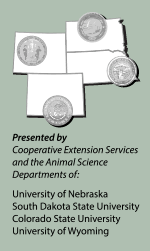Cow Supplementation
Getting the best bang for your buck.
LOVELAND, Colo. (Nov. 18, 2015) — When it comes to cow supplementation, there are two aspects to consider:
- 1. Using supplements only if needed and when they will enhance the nutritional value of the base forage, and
- 2. Determining the most cost-effective protein supplement.
That was the message SDSU Extension Beef Specialist Ken Olson shared with Range Beef Cow Symposium attendees Nov. 18 in Loveland, Colo.

Ken Olson
“It’s not one or the other; both aspects are really important to consider and to maximize the value of a supplementation program,” he said.
Olson outlined that cattle typically require some form of supplementation when they are on a diet of low-quality forage, defined as high in fiber and 7% or less crude protein. He noted that the fiber can serve as an energy source if animals can digest it, but they will likely need some protein supplementation.
He emphasized that producers must remember they are feeding the cow for “two.” He clarified he wasn’t talking about feeding a fetus or calf. Instead, Olson said, “You must feed the cow and the rumen microbes.” Rumen microbes play an important role in breaking down the fiber into an energy source.
Regarding protein supplementation, Olson said it is important to select a feedstuff with a high protein content, such as soybean meal or cottonseed meal, which rank at about 49% and 46% crude protein respectively. Additional options include byproduct feedstuffs such as distillers’ grains, corn gluten feed and wheat middlings, which range from 30% to 17% crude protein.
Protein has the role of providing nitrogen for rumen microbial activity to aid digestion, Olson said. “We can increase the nutrient value of base forages by adding protein in the form of supplementation.”
However, he cautioned, grain-based energy supplements that are high in starch and low in protein — such as corn and barley — can have a negative effect on forage intake and digestibility.
Several factors must be evaluated when pricing supplements: differences in different feedstuff price, crude protein content, moisture content and transportation costs, Olson said. “Consider cost per delivered unit of the needed nutrient.”
Editor’s Note: This summary was written under contract or by staff of the Angus Journal®, which retains the copyright. To request to reprint this article, contact Shauna Rose Hermel, editor, at 816-383-5270. PowerPoints are posted with permission of the presenter and may not be reproduced in whole or in part without the express permission of the presenter. Angus Journal claims copyright to this web site as presented. We welcome educational venues and cattlemen to link to this site as a service to their audience.
The Angus Journal's coverage of the event is made possible through collaboration with the event committee and sponsorship of LiveAuctions.tv. For questions about this site, or to notify us of broken links, click here. Look for additional coverage in the Angus Journal, the Angus Beef Bulletin, the Angus Journal Daily, the Angus Beef Bulletin EXTRA and Angus TV.


